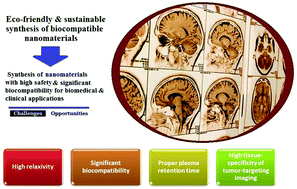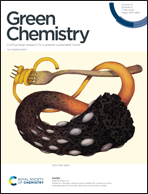Eco-friendly and sustainable synthesis of biocompatible nanomaterials for diagnostic imaging: current challenges and future perspectives
Abstract
Conventional organic dyes and inorganic fluorescent contrast agents have been obstructed in bioimaging and biomedical applications, because of their intrinsic drawbacks including toxicity and poor biocompatibility. Thus, there is a pressing need to develop innovative classes of nanomaterials and fluorescent contrast agents with merits of high photostability, remarkable safety, and significant biocompatibility for biomedical and clinical applications. In this critical review, recent trends and future prospects regarding the eco-friendly and sustainable synthesis of biocompatible nanomaterials for diagnosis/imaging, bioimaging and cellular imaging are discussed as well as important challenges for sophisticated sensitive and noninvasive clinical diagnostic imaging. Particularly, the potential of biocompatible nanocontrast agents is discussed for further improvements of magnetic resonance imaging (MRI) and computed tomography (CT) scanning performance, remarkably for cancer diagnosis/imaging and therapy. However, it appears that further investigations and comprehensive evaluations should be accomplished to find innovative strategies and relevant challenges in this important field of science.



 Please wait while we load your content...
Please wait while we load your content...